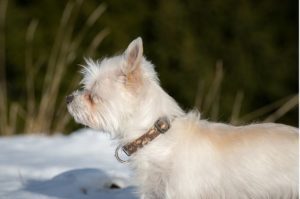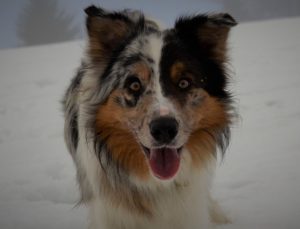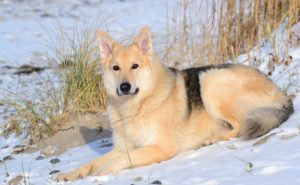Why Groom in the Winter?
Many dog owners have misconceptions about grooming and what it should entail in the winter months. Dogs are man’s best friend, and it is just as important to keep your dog up to date with their grooming schedule when the weather turns gloomy and cold.
Just because we do not think our dogs get as dirty in the winter, that is not necessarily true, and grooming should not go by the wayside. We want our dogs to look and smell good and grooming has many benefits for his or her health, especially in the cold months.
Regular grooming is essential for our dog’s physical health, but it also makes them feel better too! Grooming your dog is also an opportunity to bond and show affection for every member of your family. If grooming from home is not an option, maintain a six to eight-week schedule.
Sometimes our dogs get a little apprehensive when it is time to go to the groomer. Treats are a great way to reinforce the positivity of the grooming experience. If you are worried about your pooch while they are at the groomer, you can leave treats with them as well.
Maintaining the Coat Is Key!
General grooming of the outer and undercoats serves any number of purposes. Often, grooming stimulates hair growth. A groomed coat lessens the chance of matting and keeps your house cleaner! You will not have excess shedding and you can get rid of any of the dirt hiding in your dog’s coat. Length of hair should be determined by your lifestyle and the needs of your dog.
Just like their human counterparts, dogs need scheduled maintenance when it comes to their coats. Avoiding regular grooming increases the chance of matting in all dog breeds, but particularly with those with longer hair. Experts recommend grooming two to three times a week for needs such as brushing. This will avoid a potential overall shave, antibiotics, and medicated shampoos. It will also ensure that you do not have to make an unnecessary visit to your vet or groomer.
Keep That Fur Clean and Dry
It is vitally important for a dogs’ undercoat to be kept clean so that it functions properly. Undercoats have the potential to trap debris, which can be harmful to your dog. Just like human, if a dog’s coat gets wet, is imperative to dry them off because they get cold too! Imagine what it would feel like to walk around wet in the dead of winter. Well, our dogs are equally as susceptible to the cold as we are.
It’s Bath Time!
Artificial, dry heat is a killer for both human and dog’s skin in the winter. Believe it or not, regular bathing helps with dry skin in dogs by preventing it in the first place. In addition, our dog’s coats are also affected by the elements. Conditions like snow, cold winds and harsh chemicals that prevent ice accumulation can also be damaging to our canine’s mane.
Typically, bathing our dog’s once a month should suffice. It is especially important to use only dog shampoos and conditioners. In addition to many different types of cleansers, special shampoos aimed at dry skin are available as well. Pay attention to the condition of your dog’s skin and choose the option the best suits the needs of your pet.
Lather, Rinse and Repeat
Conditioner should be used as well, as it replenishes natural oils and helps owners with brushing afterwards. Conditioner helps to cut down on static too. It is important to dry your dog by squeezing excess water off them, rather than rubbing the fur. Rubbing the fur can cause potential tangles which will be harder to brush out later. If your dog is not afraid of the hair dryer, you can use this tool, but no high heat, only a cool or warm setting is appropriate.
Lastly, do not forget those ears. During a bath, it is likely that water will get in those cute ears. Such a thing as ear cleaner exists, so use it to remove wax and dirt, and it will also have the bonus of drying up the excess water.
In A Pinch
What if you think your dogs needs a little freshening and you do not have time for a full-on bath? Look for dog shampoo wipes. These are an easy fix to give your dog a quick clean. Make sure they contain moisturizer for the full effect without drying their skin. Similar to what we use as humans, there is a product for dogs that is like our dry shampoo. You could give that a try as well.
Moisturize, Moisturize, Moisturize
As much as we would like to think our dog’s dry skin needs lotion, be careful. The only lotion you should use on your dog needs to be pet approved. There are many types available, and in fact, some of these are spray on versions. Coconut oil is a natural alternative that works well on dog’s dry patches.
Excessive dryness can lead to itchy skin. Itchy skin means a dog will constantly scratch and we want to avoid this, as it can lead to what is called a hot spot. Hot spots are prime areas for germs to get in and pose the risk of an infection. When you are on the lookout for dry areas, do not forget about your dog’s nose. This area can also be susceptible to dry skin.
If you can believe it, snout balm is a product available to use on your dog’s sniffer. Diet can also help with dry, itchy skin. Supplements are beneficial for replenishing natural oils in a dog’s skin. Regular bathing also makes brushing your dog easier. However, the most important part of bathing is to make sure that your dog is warm while bathing and that they are completely dry before they go outside. If you find that your dog’s skin is dry, easy fixes like making sure they stay hydrated and using a humidifier might just do the trick to alleviate this issue.
Brush and Brush Again
In summer months, it can help owners to find ticks or fleas. However, do not count out the fleas just because it is wintertime. Our warm homes can provide an environment where fleas can continue to be an issue. Be on the lookout for potential indications of fleas when brushing your dog. Brushing avoids trapping bacteria in the undercoat as well. Finding these issues is important and can prevent an unwanted trip to the vet. Also, regular brushing gets rid of dead hair which offers your dog no protection from the elements.
In addition, both long and short hair breeds need brushing. How often depends on the type of coat, but you may want to increase the frequency. Areas to focus on are ones that are prone to matting including underarms, face, belly, ears, legs and tail. The area around the collar is important to note as well, as the collar can cause mats to form. In addition, make sure to brush your dog every day if the wear a sweater or coat as the friction can cause matting. Brushing also helps with blood circulation and distribution of oils essential for skin health. These oils keep away those dry patches and irritations that can arise underneath our dog’s coats.
What Should I Brush With?
Make sure have a brush that is appropriate for your dog’s coat type. Bristle brushes work well for dogs with short hair. But, if you are tackling medium to long hair breeds, start with an undercoat rake to remove matting and continue with a slicker type that will work for additional tangles and knots. It is best to work from the skin to the end of the hair.
You can also choose to use a coat spray that will help with brushing and moisturizing. In any case, brushing helps to avoid an overall shave to get rid of matting. Imagine if we did not brush our own hair regularly, the same can be applied to your pooch. In addition, do not forget about brushing your dog’s teeth. Regular brushing leads to improved dental health for your dog.
Matted Fur Is the Enemy
First and foremost, in the cold winter months, matted fur does not insulate or provide warmth for you dog. In addition to this basic discomfort, matting can also cause pain, hot spots and infections below the undercoat on the skin. This can affect movement and make fur harder to clean. Matting can occur with shorter hair, but is obviously more common in longer haired breeds.
If a dog owner puts off brushing for too long, matting is inevitable and can become unmanageable. If you encounter debris stuck in your dog’s fur, use your fingers and comb to remove any foreign matter. Then, run your hands along your dog’s fur to make sure nothing remains. Keep on top of those tangles to avoid matting and a possible overall shave with one of these best dog clippers for matted fur/hair.
A Cut Here a Cut There
Dogs with longer coats fur might hold salt crystals or ice balls and it is important to tackle those right away. Understand that grooming your dog’s coat is fine in the cold. Keep in mind that just like humans, dogs get cold too, so do not leave them outside for too long. If you are still concerned with cutting your dog’s hair, consider leaving it a little bit longer than you usually cut it in the warm weather.
What About the Paws?
There are three main elements to consider, regarding keeping your dog footloose and fancy free in the winter months. Nails, hair between toes and the undersides of paws are all areas dog owners need to pay special attention to when the weather turns chilly.
Watch the Nails
As stated above, both we and our pets are naturally less active outdoors in the cold. Typically, when the weather is nice, our dogs wear down their nails during walks on concrete or asphalt, adding time in between regular nail trimmings. While some dogs and owners brave the elements, walks are typically shorter when it is cold.
In addition, longer nails can also gather snow, salt, or other harsh chemicals we use to keep ice at bay. As dog owners, we sometimes take it easier with the grooming, including nails, when we roll into winter, but make sure to keep on top of the trimming. Winter conditions can make nails brittle, which in turn, makes it more painful for our dogs to walk. We would not want our favorite companions to be in pain, so keep up those trims!
A Spa Day at Home for Your Pooch
Owners can purchase nail trimmers or files at most pet stores. We do not want our canine pals to lose their balance on ice or snow, which can happen if nails get too long. Listen for that click, click, and you will know it is time to trim. Make sure to consider the nails, but other places on your dog’s paws as well.
Hair Everywhere
We often forget about that tuft, or more than a tuft of hair that grows in between our dog’s toes. If snow gets stuck in this small space, it can potentially lead to frostbite. Again, with the salt? Yes, this can get stuck in that hair along with other chemicals used to prevent ice accumulation. Our dogs may also want to lick that off their paws, leading to gastrointestinal or electrolyte issues.
It is as important to wipe these chemicals off dog’s paws as it is to clean them when they are muddy in the spring or summer. You can take further action by making sure that the hair between toes is trimmed as well. It would not be a bad idea to keep a bowl of warm water by the door and rinse each paw and pat dry thoroughly to remove moisture.
Boots for Me, Boots for You
If your dog will tolerate them, dog boots are one of the many products available to protect those precious paws. If not, there are other alternatives available including a dog-friendly wax to make sure we safeguard our dog’s feet. Cracks can lead to infection, so it is important that owners choose products that help to nourish our dog’s paws. Avoid coconut oil on the paw pads, as dogs are likely to lick it off. Rubbing neem oil onto the pads of the feet while your dog is indoors will help to moisturize those pads and help prevent future cracking.
When it comes to grooming your dog in the winter, there are many areas in which we need to keep diligent. Also make sure that you are equipped with the right tools like a dog bath tub and a dog grooming table. Many things go by the wayside when we hunker down for winter but grooming your dog should not be one of them. Whether it is making sure your dog is clean and dry or watching the length of their nails, we need to keep on top of maintaining a healthy grooming schedule for our dog. Our best friends deserve it!


![12 Best Dog Foods for Toy Breeds [Buyer's Guide] 12 Best Dog Foods for Toy Breeds [Buyer's Guide]](https://shihtzuexpert.com/wp-content/uploads/2019/05/3-5.jpg)
![12 Best Dog Clippers for Shih Tzu [Fun & Easy Grooming] 12 Best Dog Clippers for Shih Tzu [Fun & Easy Grooming]](https://shihtzuexpert.com/wp-content/uploads/2017/04/Best-Dog-Clippers-for-Shih-Tzu-1.png)
![10 Best Dog Crates for Separation Anxiety [High anxiety dog crates 2019 Reviews] 10 Best Dog Crates for Separation Anxiety [High anxiety dog crates 2019 Reviews]](https://shihtzuexpert.com/wp-content/uploads/2019/05/5-3.jpg)
![6 Best Dog Treadmills for 2023 [Buyer’s Guide] 6 Best Dog Treadmills for 2023 [Buyer’s Guide]](https://shihtzuexpert.com/wp-content/uploads/2019/04/Best-Dog-Treadmills-1.png)


